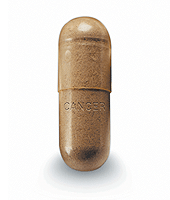Common Prescriptions Linked To Cancer
Canadians spend an estimated $15.5 billion annually on drugs, according to the Canadian Institute for Health Information. This represents 15.2 per cent of total health-care spending.

Since drugs are potent chemicals designed to affect bodily processes, the question arises: What is this chemical burden doing to us? According to Samuel S. Epstein, MD, and David Steinman, authors of The Breast Cancer Prevention Program (Macmillan, 1998), "Clear evidence exists that medical technology has outpaced our ability to recognize and control its side-effects."
While we don't have all the answers, research shows some common drugs increase our cancer risk. A study in British Journal of Cancer (Jan. 7, 2002) explored the effect of 10 tricyclic antidepressants. Those shown to more than double breast-cancer risk include: amoxapine (brand name Asendin), clomipramine (Anafranil), desipramine (Norpramin) and trimipramine (Surmontil and Rhotrimine). For those in the study who took tricyclic medications, breast cancer did not show up until 11 to 15 years afterward. Another study, published in volume 151 of the American Journal of Epidemiology, also showed a doubling of breast cancer risk among women who took tricyclic antidepressants for two years or more.
More than one million Canadians are believed to currently suffer from depression. One in four Canadian women now being treated with depression drugs take tricyclics.
The American Journal of Epidemiology study also found that another antidepressant, Paroxetine (Paxil), one of the class of antidepressants known as selective serotonin reuptake inhibitors (SSRIs), causes a seven-fold increase in breast cancer risk. In addition, both amitryptiline
hydrochloride (Elavil) and fluoxetine hydrochloride (Prozac) have been shown to promote mammary tumours in rodents, according to a 1992 study in volume 52 of Cancer Research.
Various blood pressure-lowering drugs are also linked to cancer. The research on resperine (Serpasil, Ser-Ap-Es) dates back to the early 1970s. The drug increases blood concentration of prolactin, a pituitary hormone that stimulates the growth of invasive breast cancer, especially among premenopausal women. Other blood pressure drugs associated with breast cancer include hydralazine (Apresoline), spironolactone (Aldactone) and atenolol (Tenormin).
Two types of commonly used cholesterol-lowering drugsstatins and fibrates-have come under fire. In 1996, the Journal of the American Medical Association warned they caused breast and other cancers in rodents, stating people should avoid their use. A previous drug industry-funded study of pravastatin (Pravachol) found a rate of breast cancer 12 times higher in users than non-users, although the drug's manufacturer, Bristol-Myers Squibb, labelled the result a "statistical fluke."
More than $600 million is spent on antibiotic prescriptions in Canada annually, according to the Canadian Committee on Antibiotic Resistance. Two types of antibiotics, metronidazole and nitrofuranzone, increase breast cancer risk. In one 1979 study in the Journal of the National Cancer Institute, taking metronidazole (Flagyl), commonly prescribed for vaginal yeast infections, showed noteworthy excesses of breast cancer in male rodents." Researchers said the drug had "considerable carcinogenic potential," a finding backed by later studies. Similarly, two studies-one in Cancer Research (1970) and the other by the National Toxicological Program (1998), showed the antibiotic nitrofurazone (Furacin and Furoxone), significantly boosted breast cancer in rodents.
Stomach aid remedies are a top seller in Canadian pharmacies; pills, liquids and effervescent antacids sell $52.6 million a year, according to ACNielsen MarketTrack. One popular antacid, Tagamet, now available over-the-counter and by prescription, appears to disrupt the body's estrogen metabolism. Tagamet decreases levels of "good" estrogen and boosts "bad" estrogen. This is believed to cause breast enlargement in men and may be related to a case of breast cancer in one man treated with Tagamet for eight months. The study, published in The Lancet in 1981, indicates the need for more research on this connection.
Last but not least are the cancer risks associated with estrogen hormone replacement therapy (HRT). The first reports of its connection to endometrial cancer came out in the 1970s. Now we know HRT is associated with breast, endometrial, liver and ovarian cancers, as well as benign breast disease, uterine fibroids, gallstones and blood clots. Adding progestins or testosterone to the pills doesn't reduce the risk, but rather can enhance the carcinogenic effect of estrogen-up to 400 percent according to a 1989 study in the New England Journal of Medicine, The Women's Health Initiative study, halted last July after five years, found the combination of estrogen and progestins caused a 41 percent increase in the risk of stroke, a 29 percent increase in heart attack risk, doubled risk of blood cots, 22 percent increase in cardiovascular disease and 26 percent increase in invasive breast cancer risk.
In the end, it appears that drug approval doesn't mean much-not if consumers find out five, 10 or 15 years later that they've been taking something that may cause more harm than good. Talk to your wholistic health-care provider about safer, natural alternatives to pharmaceuticals to avoid increasing your cancer risks.




